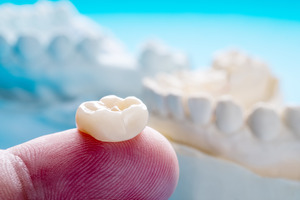
Dental crowns often last around 10 to 15 years, but sometimes your restoration may fall out of your mouth before then. A lost dental crown isn’t as urgent as a knocked-out tooth or severe dental pain, but it’s still a problem that needs to be addressed by a professional as soon as possible. If you ever find yourself with a crown that has fallen off your tooth, follow these tips to keep the situation under control.
Find the Crown and Inspect It
Before anything else, you’ll want to retrieve the crown and check it for damage. A severely broken crown will likely have to be replaced, but if it’s still mostly intact, it might be possible to reuse it. Put your dental crown in a safe container and don’t forget to bring it with you when you leave for the dentist’s office.
Make an Appointment as Soon as You Can
A lost dental crown doesn’t always require a same-day appointment, but you don’t want to wait too long to see your dentist. The longer the affected tooth is left exposed, the more likely it is to suffer from further damage and decay. Reach out to your dentist as soon as your crown is lost so that you can schedule an appointment for the near future.
If Possible, Put the Crown Back on the Tooth
It’s sometimes possible to put a lost crown back on the tooth. After cleaning the inside of the crown, you can apply a dab of toothpaste to act as an adhesive before putting it back in its proper place. Obviously, this is only a temporary fix; you’ll still need to see your dentist for a permanent solution.
Keep Your Mouth Clean
Once you lose a crown, the tooth it used to protect will be vulnerable to attacks from harmful oral bacteria. As such, good oral hygiene is essential for keeping the affected tooth safe until you can get to your dentist’s office. Remember to brush thoroughly at least two times every day; rinsing with salt water can also help.
Be Careful About What You Eat
There are certain foods that you should avoid after a crown is lost. For example, hot or cold foods could cause discomfort if the tooth is sensitive. Furthermore, trying to chew on anything hard might damage the tooth further. To be safe, you should stick to soft foods as much as possible and chew away from the side of your mouth where the tooth in question is located.
Get the Care You Need
Once you get to your dentist’s office, they can take the necessary steps to properly reattach the crown to your tooth. In the event that the crown can no longer be used, your dentist will likely recommend having a new restoration made. Once your tooth is protected by a crown again, your smile will be much safer.
About the Author
Dr. Kamlesh Makwana loves how being a dentist allows him to change people’s lives for the better. He earned his Doctor of Dental Surgery at Marquette University in 1996. Today at Cayo Dental Care in St. Peters, he restores smiles with lifelike dental crowns, and he offers emergency care for patients with urgent oral health issues. To schedule a consultation with Dr. Makwana, visit his website or call (636) 928-9693.

